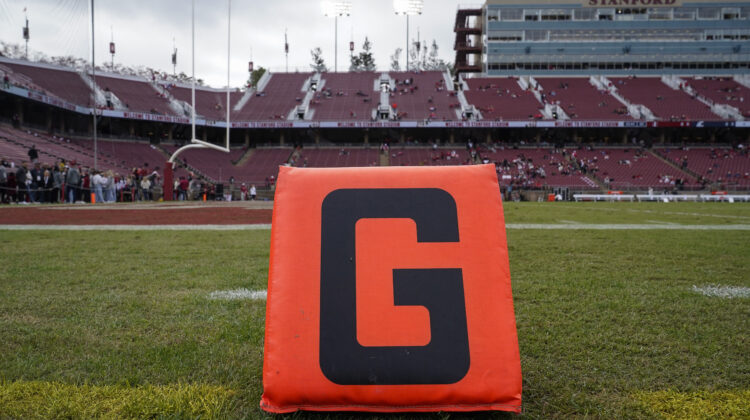It was the summer of devastation for the Pac-12, the summer the conference collapsed in ash and ruin.
It was the summer of 1959.
A pay-for-play scandal at four schools (UCLA, USC, Cal and Washington) led to the breakup of what was then known as the Pacific Coast Conference.
From that carnage, the modern Pac-12 was born.
What will the post-modern Pac-12 look like?
As of next summer, only four schools will remain following the mass exodus late last week: Cal, Stanford, Oregon State and Washington State.
Will they stick together and reform the conference? Or is this the final year for a league created in a Portland hotel in 1915?
Presenting our five-step guide to rebuilding the conference.
Step 1: Clarity on Stanford (and Cal)
Both Stanford president Marc Tessier-Lavigne and Cal chancellor Carol Christ were surprised when the Pac-12 collapsed on Friday despite numerous warning signs, according to a conference source. Now, they are scrambling to find homes for their athletic departments.
Stanford has mustered its influential alumni network and is pushing for membership in the Big Ten and ACC, with Cal as a possible travel partner, multiple industry sources said. Answers from both leagues are expected this week, with membership invitations considered unlikely.
(A six-team western arm of the Big Ten, with Stanford and Cal joining USC, UCLA, Washington and Oregon, makes loads of logistical sense. But Fox, which controls the Big Ten’s media rights, would have to fund the Bay Area additions — and the cost could approach $150 million.)
Stanford is considered essential to any rebuilt Pac-12 because of the university’s national brand, deep ties to Silicon Valley power and the football program’s recent history of success (2009-2018).
If the Cardinal and Bears land in the Big Ten or ACC — or decide to compete as Independents — then Washington State and Oregon State likely would move into the Mountain West.
If the Bay Area schools don’t relocate their football programs, the four schools likely will stick together and work to rebuild the shattered conference.
Of note: The University of California Board of Regents will convene in closed session tomorrow to discuss Cal’s plight.
Step 2: Convene the attorneys
If the four schools opt to rebuild, they must first identify the resources available for the project.
How much cash resides in the Pac-12’s emergency reserves?
How much debt will remain at the end of the 2023-24 fiscal year? What are the liabilities?
And critically: Do they have the authority, as the remaining members of the Pac-12, to withhold any forthcoming revenue distributions from the eight outgoing schools?
The conference will generate more than $500 million in the 2024 fiscal year from broadcast contracts, the NCAA Tournament and the College Football Playoff.
The general counsels from the four schools will undoubtedly comb through the bylaws and budget this week.
Much rests on the amount of cash available, which could be used to help new members pay the departure penalties from their current conferences.
For example, any Mountain West team attempting to join the Pac-12 next summer would owe about $34 million in exit fees.
Step 3: Solve the Kliavkoff question
The presidents of the remaining schools form the Pac-12’s board of directors, with one voice seemingly more influential than the others. Washington State’s Kirk Schulz is not only the current chair of the Pac-12 Board of Directors but also vastly more experienced in college sports than his peers.
Oregon State president Jayathi Murthy has been on the job for less than one year.
Cal chancellor Carol Christ is retiring next summer.
Stanford president Tessier-Lavigne is stepping down at the end of the month following an academic scandal, with Richard Saller taking over as the school’s interim boss.
But Schulz cannot handle the daily duties of rebuilding the conference; he’s busy running a state-wide university system.
The essential strategic decisions — identifying expansion candidates and landing a new media contract are atop the list — are the commissioner’s responsibility.
That would be George Kliavkoff, at least for the time being.
He has been in charge of the Pac-12 for two years, lost eight schools and failed in the only task that mattered: securing a media rights deal that would save the conference.
Asked if he planned to resign, Kliavkoff said (via text message):
“I’m loyal to a fault (and probably to my personal detriment). Had plenty of chances to leave over the past two years when the breadth of the challenges were already obvious and decided to stick it out and try to do the best I could. We still have a lot of work ahead of us to try and minimize the impact on the student athletes, and I’m still committed to that.”
So in addition to everything else, the four presidents must decide whether to keep Kliavkoff or find a permanent or interim replacement. (The change would be costly: Kliavkoff is believed to earn about $3.5 million annually and likely has three years remaining on his deal.)
If the schools make a change and hire an interim commissioner to get through the storm, our suggestion is Bob Thompson, the retired Fox Sports president and Oregon alum.
Step 4: Expand by four (or more)
If the four schools decide to rebuild the Pac-12, they must add at least two members in order to become an officially recognized conference by the NCAA.
But a conference of six schools doesn’t work for a variety of reasons, with scheduling atop the list. The Pac-12 would need at least four schools, and perhaps six, to become viable.
The Pac-4 could attempt to lure a handful of schools from the Mountain West, with an emphasis on media value and football success.
But the schools should think bigger, both in numbers and in scope. In our view, they should add schools from the American Athletic Conference and form a 10-team league.
In addition to a combination of San Diego State, Fresno State, Colorado State and Boise State from the Mountain West, why not add SMU, Rice and Tulane from the American?
All three are top-notch academic schools, which shouldn’t be a consideration at this point but probably is for Stanford and Cal.
SMU and Rice are located in major markets, Dallas and Houston, respectively, while Tulane extends the footprint to New Orleans. (Also, the Green Wave just beat USC in the Cotton Bowl.)
And you know what else? The Pac-12 should make a hard run at Gonzaga as a non-football member to uplift the men’s basketball product.
The Zags would make more money in a rebuilt Pac-12 than they do in the WCC, in part because the conference would be entitled to all the March Madness revenue generated by the eight departing schools. (They cannot take the NCAA units with them into the new leagues.)
The Zags could increase their revenue base without having to join a vastly more competitive conference — the best of both worlds for coach Mark Few’s program.
Step 5: Land a media deal
College football is run by the major networks, Fox and ESPN. They are the grandmasters, with the conferences and schools as pawns. The Pac-12 was set to survive its existential crisis until Fox mustered the $350 million (approximately) to pay for Oregon and Washington.
We’re skeptical of either network forging a broadcast relationship with the reformed Pac-12. But the remaining schools — and any additions — must secure a media rights agreement for the contract cycle that begins next summer.
A rebuilt conference that includes the top tier of the Mountain West, plus SMU and Rice, would provide any linear media partner with exposure in several major media markets.
Or perhaps Apple, which was on the brink of a deal with the Pac-12 last week that would have paid each school $25 million annually in guaranteed cash, would offer half that amount as a means of gaining a toehold in college sports.
Stanford, Cal, WSU and OSU would have to restructure their athletic departments to account for a massive drop in revenue, but they might not have a choice if membership in the ACC and Big Ten doesn’t materialize.
Any deal in a rebuilt Pac-12 that pays $10 million or more annually would approximately double the amount San Diego State and Fresno State receive from the Mountain West’s broadcast deal with Fox and CBS. It would constitute a jackpot for SMU, Rice and Tulane, as well.
This much is clear: There are expansion options for the Pac-12, and there might be a media deal, as well … if the four schools stick together.
*** Send suggestions, comments and tips (confidentiality guaranteed) to pac12hotline@bayareanewsgroup.com or call 408-920-5716
*** Follow me on Twitter: @WilnerHotline
*** Pac-12 Hotline is not endorsed or sponsored by the Pac-12 Conference, and the views expressed herein do not necessarily reflect the views of the Conference.





